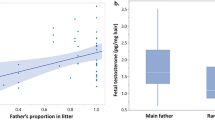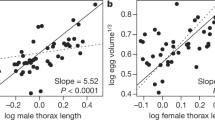Abstract
All else being equal, females would double their fecundity through parthenogenetic reproduction. On the other hand, males should be subject to positive selection pressures to coerce parthenogenetic females into sexual fertilization, because the twofold advantage of parthenogenesis is achieved at the expense of the male genetic contribution. Interestingly, although male coercion superficially imposes the cost of sex on parthenogenetic females, it would confer a reproductive benefit even on the parthenogens. This is because females fertilized by coercive males gain indirect reproductive success via sons inheriting coercion, who would succeed in mating with other parthenogens in the next generation (sons’ effect). In this study, using two mathematical models, I show for the first time that the indirect sons’ effect of male coercion plays an important role in the maintenance of sex in potentially parthenogenetic species. The first model, which compares the fitness of a female reproducing parthenogenetically with that of a female mating with a coercive male, demonstrates that the sons’ effect can outweigh the cost of sex and resolve sexual conflict over reproductive modes. My second model of population genetics, which analyses the dynamics of coercion and parthenogenesis, shows that the occurrence of parthenogenetic reproduction is suppressed in the presence of the sons’ effect of male coercion. These results indicate that the sons’ effect of male coercion helps to maintain sexual reproduction at an evolutionary time scale, as well as offset the twofold cost of males in the invasion phase of the coercion.




Similar content being viewed by others
References
Andrès JA, Morrow EH (2003) The origin of interlocus sexual conflict: is sex-linkage important? J Evol Biol 16:219–223
Arnqvist G, Rowe L (2005) Sexual conflict. Princeton University Press, Princeton
Bell G (1982) The masterpiece of nature: the evolution and genetics of sexuality. University of California Press, Berkley
Cameron ET, Rowe L (2003) Sexual conflict and indirect benefits. J Evol Biol 16:1055–1060
Chapman T, Arnqvist J, Bangham J, Rowe L (2003) Sexual conflict. Trends Ecol Evol 18:41–47
Charlesworth D, Morgan MT, Charlesworth B (1993) Mutation accumulation in finite outbreeding and inbreeding populations. Genet Res 61:39–56
Conallon TR, Cox M, Calsbeek R (2009) Fitness consequences of sex-specific selection. Evolution 64:1671–1682
Corley LS, Moore AJ (1999) Fitness of alternative modes of reproduction: developmental constraints and the evolutionary maintenance of sex. Proc R Soc Lond B 266:471–476
Dagg JL (2006) Could sex be maintained through harmful males? Oikos 112:232–235
D’Souza TG, Michiels NK (2010) The costs and benefits of occasional sex: theoretical predictions and a case study. J Hered 101:S34–S41
Engelstädter J (2008) Constraints on the evolution of sexual reproduction. BioEssays 30:1138–1150
Fisher RA (1930) The genetical theory of natural selection. Oxford University Press, Oxford
Gavrilets S (2000) Rapid evolution of reproductive barriers driven by sexual conflict. Nature 403:886–889
Gavrilets S, Arnqvist G, Fibers U (2001) The evolution of female mate choice by sexual conflict. Proc R Soc B 268:531–539
Godfray HCJ (1995) Evolutionary theory of parent-offspring conflict. Nature 376:1133–1138
Greeen RF, Noakes DLG (1995) Is a little bit of sex as good as a lot? J Theor Biol 174:87–96
Hamilton WD (1980) Sex versus non-sex versus parasite. Oikos 35:282–290
Hamilton WD, Axelrod R, Tanese R (1990) Sexual reproduction as an adaptation to resist parasites. Proc Natl Acad Sci USA 87:3566–3573
Hurst LD, Peck JR (1996) Recent advances in understanding of the evolution and maintenance of sex. Trends Ecol Evol 11:46–52
Iwasa Y, Pomiankowski A, Nee S (1991) The evolution of costly mate preferences. II. The “handicap” principle. Evolution 45:1431–1442
Jennions MD, Kokko H (2010) Sexual selection. In: Westneat DF, Fox CW (eds) Evolutionary behavioral ecology. Oxford University Press, Oxford, pp 343–364
Kawatsu K (2013a) Sexually antagonistic coevolution for sexual harassment can act as a barrier to further invasions by parthenogenesis. Am Nat 181:223–234
Kawatsu K (2013b) Sexual conflict over the maintenance of sex: effects of sexually antagonistic coevolution for reproductive isolation of parthenogenesis. PLoS ONE 8:e58141
Keightley PD, Eyre-Walker A (2000) Deleterious mutations and the evolution of sex. Science 290:331–333
Kirkpatrick M (1982) Sexual selection and the evolution of female choice. Evolution 36:1–12
Kondrashov AS (1988) Deleterious mutations and the evolution of sexual reproduction. Nature 336:435–440
Kondrashov AS (1993) Classification of hypotheses on the advantage of amphimixis. J Hered 84:435–441
Kramer MG, Templeton AR, Miller KG (2002) Evolutionary implications of developmental instability in parthenogenetic Drosophila mercatorum. I. comparison of several strains with different genotypes. Evol Dev 4:223–233
Lamatsch DK, Stöck M (2009) Sperm-dependent parthenogenesis and hybridogenesis in teleost fishes. In: Schön I, Martens K, van Dijk P (eds) Lost sex: the evolutionary biology of parthenogenesis. Springer, New York, pp 399–432
Lande R (1980) Sexual dimorphism, sexual selection, and adaptation in polygenic characters. Evolution 34:292–307
Lehtonen J, Jennions MD, Kokko H (2012) The many costs of sex. Trends Ecol Evol 27:172–178. doi:10.1016/j.tree.2011.09.016
Matsuura K, Nishida T (2001) Comparison of colony foundation success between sexual pairs and female asexual units in the termite Reticulitermes speratus (Isoptera: Rhinotermitidae). Popul Ecol 43:119–124
Maynard Smith J (1978) The evolution of sex. Cambridge University Press, Cambridge
Otto SP, Nuismer SL (2004) Species interactions and the evolution of sex. Science 304:1018–1020
Parker GA (1979) Sexual selection and sexual conflict. In: Blum MS, Blum NA (eds) Sexual selection and reproductive competition in insects. Academic Press, London, pp 123–166
Parker GA (2006) Sexual conflict over mating and fertilization: an overview. Philos Trans R Soc B 61:235–259
Rankin DJ (2008) Can punishment maintain sex? Oikos 117:173–176
Rice WR, Holland B (1997) The enemies within: intergenomic conflict, interlocus contest evolution (ICE), and the intraspecific Red Queen. Behav Ecol Sociobiol 18:922–929
Scali V (2009) Metasexual stick insects: model pathways to losing sex and bringing it back. In: Schön I, Martens K, van Dijk P (eds) Lost sex: the evolutionary biology of parthenogenesis. Springer, New York, pp 317–345
Schwander T, Vuilleumier S, Dubman J, Crespi BJ (2010) Positive feedback in the transition from sexual reproduction to parthenogenesis. Proc R Soc B 277:1435–1442
Simon JC, Delmotte F, Rispe C, Crease T (2003) Phylogenetic relationship between parthenogenesis and their sexual relatives: the possible route to parthenogenesis in animals. Biol J Linn Soc 79:151–163
West SA, Lively CM, Read AF (1999) A pluralist approach to sex and recombination. J Evol Biol 12:1003–1012
Williams GC (1975) Sex and evolution. Princeton University Press, Princeton
Acknowledgments
I thank Dr. Kenji Fujisaki for help with this study. I also thank two anonymous reviewers for helpful discussions. This work was supported by Research Fellowships for Young Scientists awarded by the Japan Society for the Promotion of Science (JSPS).
Author information
Authors and Affiliations
Corresponding author
Rights and permissions
About this article
Cite this article
Kawatsu, K. Breaking the parthenogenesis fertilization barrier: direct and indirect selection pressures promote male fertilization of parthenogenetic females. Evol Ecol 29, 49–61 (2015). https://doi.org/10.1007/s10682-014-9749-0
Received:
Accepted:
Published:
Issue Date:
DOI: https://doi.org/10.1007/s10682-014-9749-0




